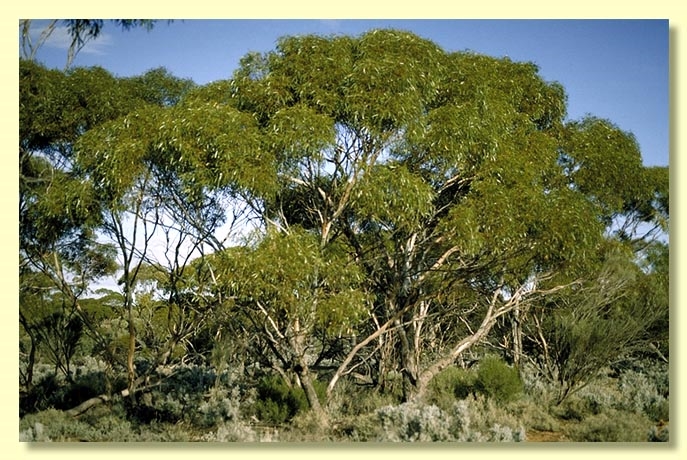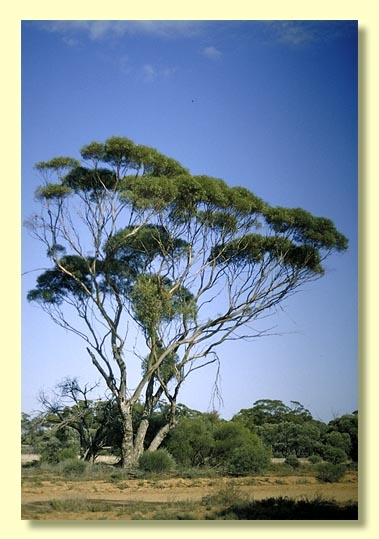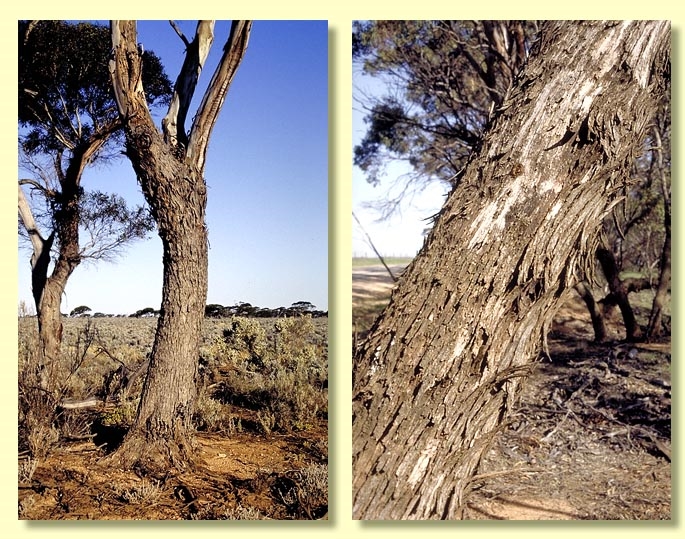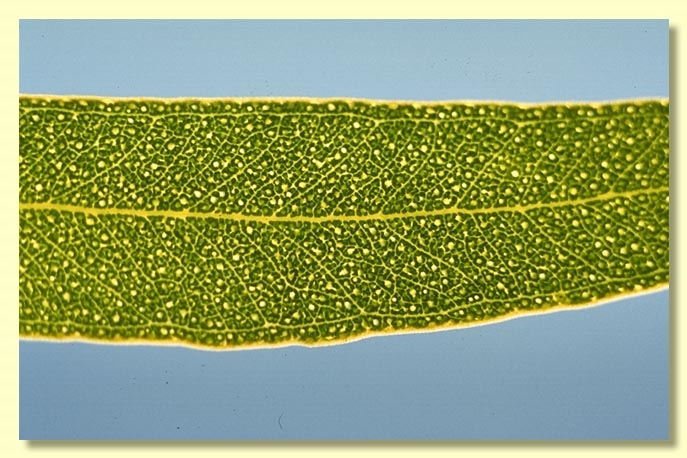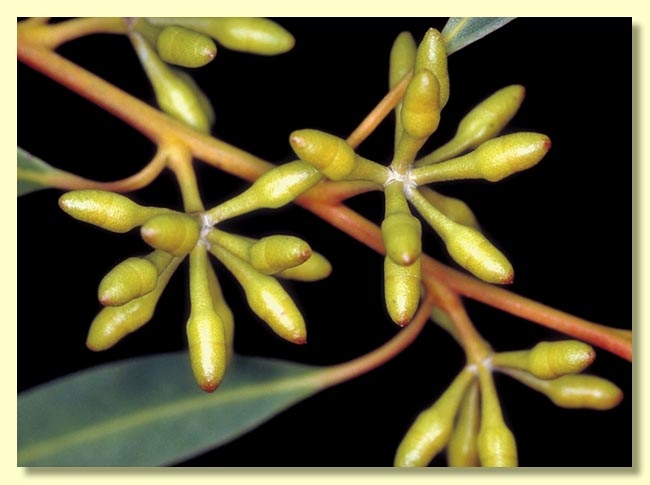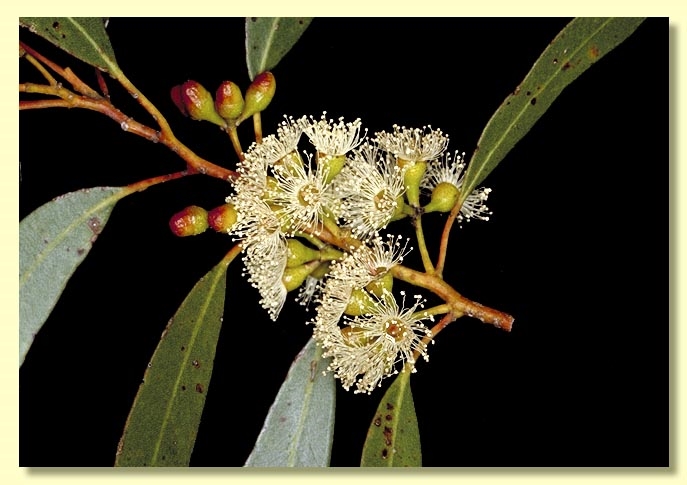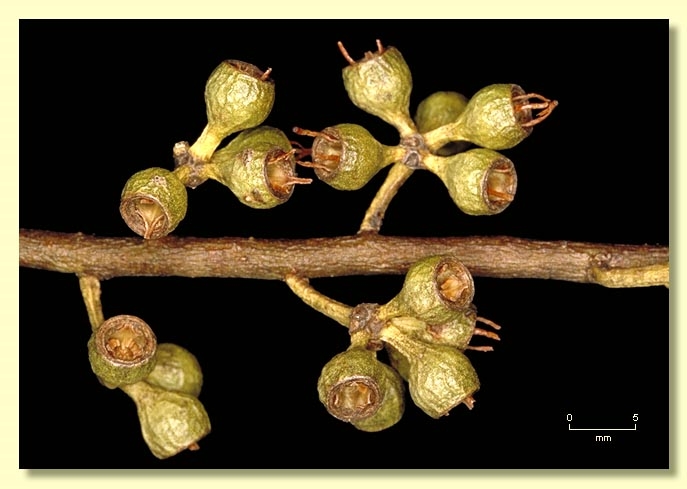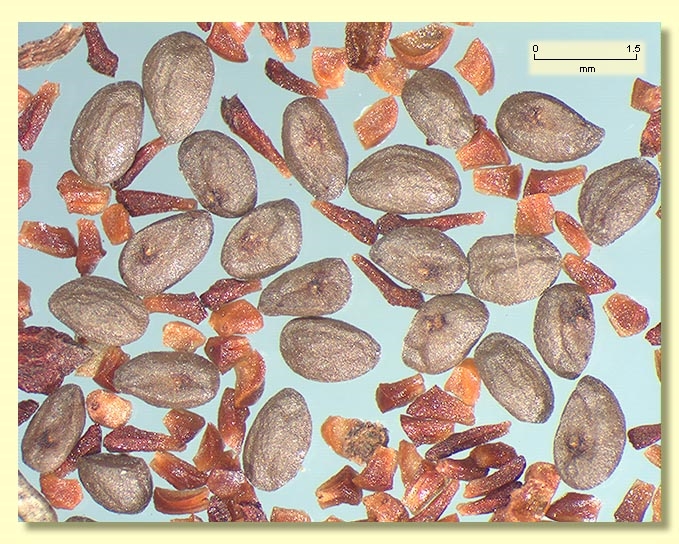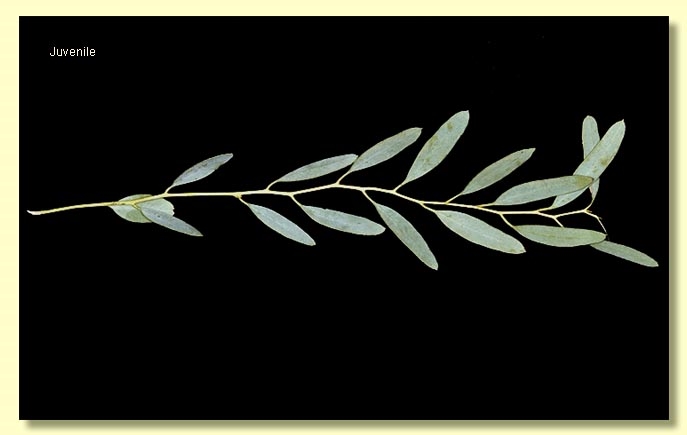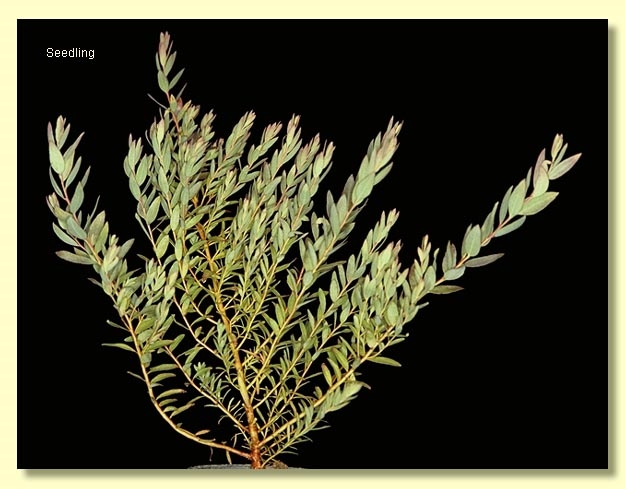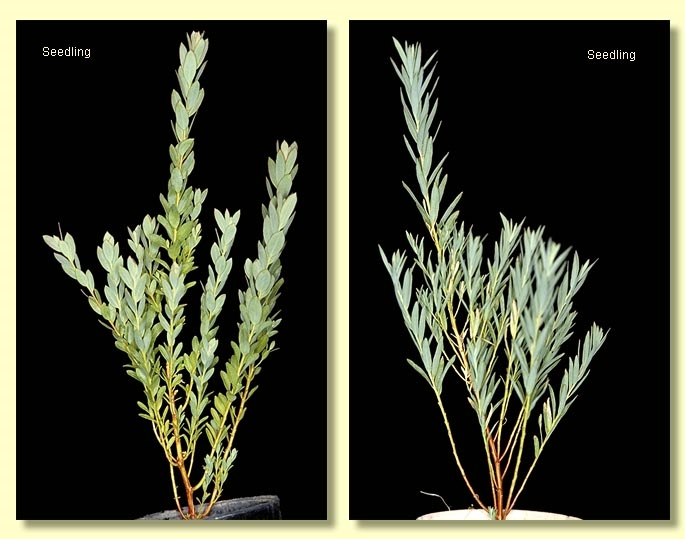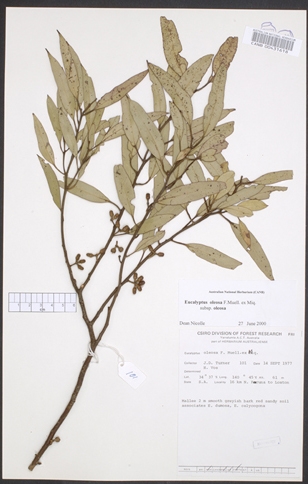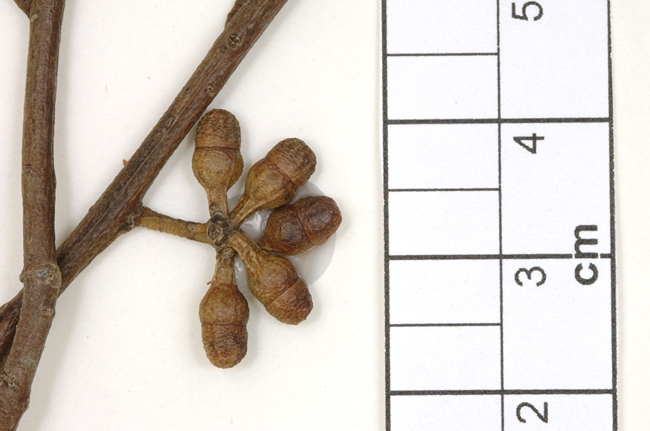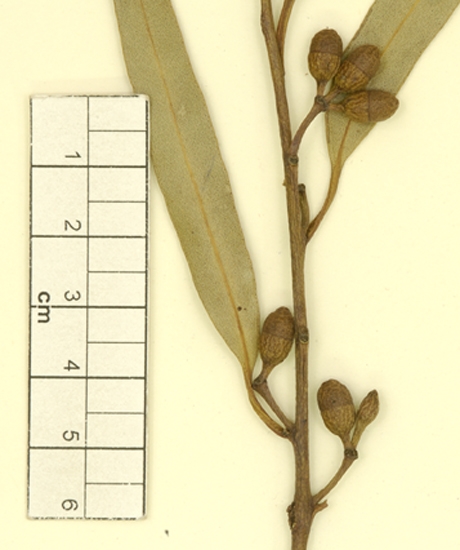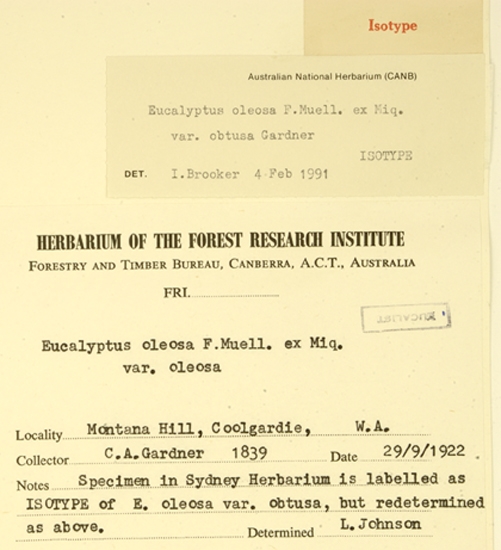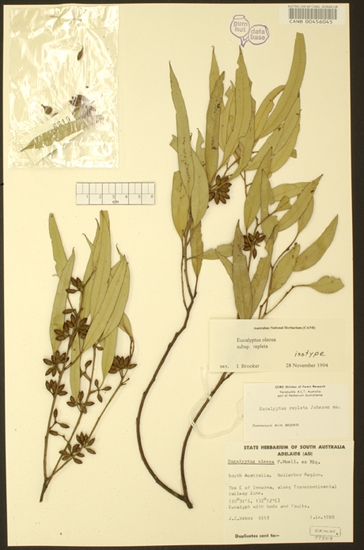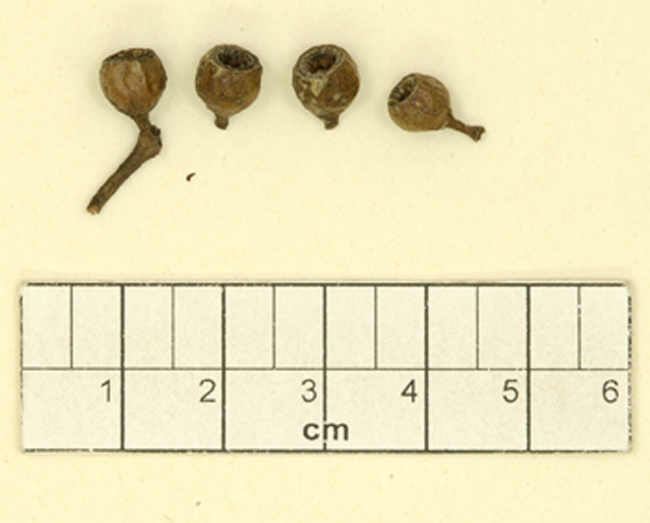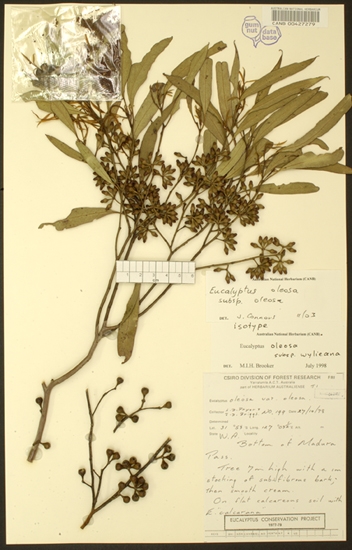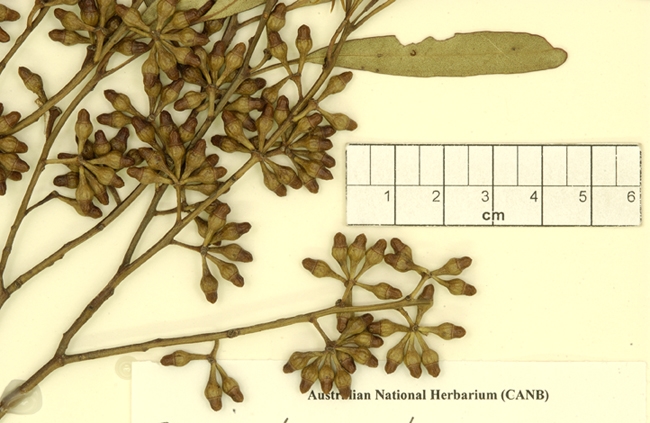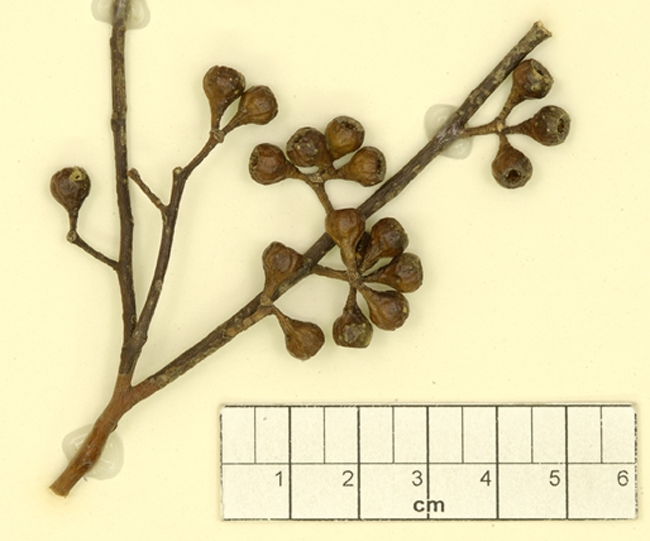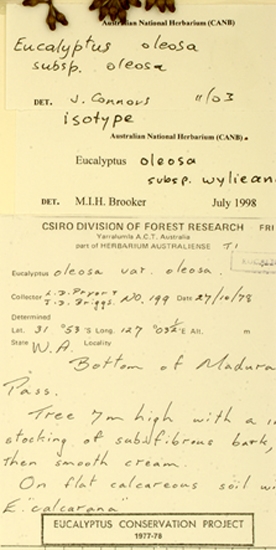Euclid - Online edition
Eucalyptus oleosa subsp. oleosa
Eucalyptus | Symphyomyrtus | Bisectae | Destitutae | Subulatae | Spirales
T: Victoria, Murray Scrub, H. Behr s.n.; lecto; U, fide M.I.H.Brooker, Brunonia 2: 153 (1979), by exclusion; isolecto: MEL. The correct identity of this lectotype is ambiguous and the following specimen has been nominated by Nicolle & Whalen as an epitype: 16 km north of Paruna to [towards] Loxton, South Australia, J.D.Turner 101 and H.Vos , 14 September 1977; epitype AD; isoepitypes CANB, MEL, NSW, PERTH.
Eucalyptus grasbyi Maiden & Blakely, Crit. Revis. Eucalyptus 8: 40 (1929). T: Western Australia: Lake Barlee, Sept. 1919, F. Fraser s.n. through W.C.Grasby; holo: NSW; iso: CANB, K, PERTH.
Eucalyptus oleosa subsp. ampliata L.A.S.Johnson & K.D.Hill, Telopea 8 (2) 179 (1999). T: South Australia: 11.6 km W of Wirrula on Eyre Highway (32° 25'S 134° 24'E),16 Oct. 1983, K.D.Hill 157 & L.A.S.Johnson; holo: NSW.
Eucalyptus oleosa subsp. repleta L.A.S.Johnson & K.D.Hill, Telopea 8 (2) 176 (1999). T: South Australia: 7 km E of Immarna along transcontinental railway line (30° 31'S 132° 12'E),1 Sep. 1980, J.Z.Weber 6619; holo: NSW; iso: AD, CANB.
Eucalyptus oleosa subsp. victima L.A.S.Johnson & K.D.Hill, Telopea 8(2) 179 (1999). T: South Australia: c. 4 km from Bute on Wokurna Road (c. 130 km NNW of Adelaide), 5 July 1967, B.Copley 1650; holo: NSW; iso: AD.
Eucalyptus oleosa subsp. wylieana L.A.S.Johnson & K.D.Hill, Telopea 8(2) 180 (1999). T: Western Australia: bottom of Madura Pass (31° 53'S 127° 03.5'E), 27 Oct. 1978, L.D.Pryor & J.D.Briggs 199; holo: NSW; iso: CANB, PERTH.
Bark usually rough on lower stems, flaky or fibrous, usually loose, grey to grey-brown, at times with short ribbons of decorticated bark in the upper branches; occasionally smooth barked to ground level, cream, grey-yellow, pink, brown or coppery.
Branchlets lacking oil glands in the pith; rarely glaucous (e.g. Lake Barlee area, WA) .
Juvenile growth (coppice or field seedlings to 50 cm): stems more or less round in cross-section; juvenile leaves alternate, sessile to shortly petiolate, elliptical to lanceolate to oblong, 4.5–8 cm long, 0.4–2.2 cm wide, bluish green to grey-green.
Adult leaves alternate, petiole 0.7–2(2.5) cm long; blade narrowly lanceolate to lanceolate, (4.5)5.5–10 (12) cm long, 0.5–2(2.2) cm wide, base tapering to petiole, concolorous, glossy, green, side-veins at an acute or wider angle to midrib, densely to very densely reticulate, intramarginal vein parallel to and just within margin, oil glands mostly intersectional.
Inflorescence axillary unbranched, peduncles 0.4–1.3(1.7) cm long, buds 7, 9 or 11, pedicellate, pedicels 0.2–0.6 cm long. Mature buds ovoid to broadly fusiform, egg-in-eggcup (0.6–1.3 cm long, 0.3–0.6 cm wide), scar present, operculum rounded or broadly and bluntly conical (0.3–0.8 cm long), usually narrower than the hypanthium at the join, stamens irregularly flexed, anthers weakly versatile or adnate, basifixed, globoid to cuboid, dehiscing by broad lateral pores, style long, stigma tapered or blunt, locules 3 or 4, the placentae each with 4 vertical ovule rows. Flowers white.
Fruit pedicellate, pedicels 0.2–0.7 cm long, truncate-globose, 0.4–0.7 cm long, 0.4–0.8 cm wide, disc usually descending, valves 3 or 4, valve tips strongly exserted due to fragile style remnants.
Seeds brown or grey, 1–2 mm long, ovoid or flattened-ovoid, occasionally with shallow longitudinal furrows on otherwise smooth dorsal surface, hilum ventral.
Cultivated seedlings (measured at node 10): cotyledons Y-shaped (bisected); stems appearing round in cross-section but in reality more or less 5 -sided; leaves opposite, sessile and linear for the first 2–3 nodes then spirally arranged, sessile and becoming elliptical to narrowly lanceolate further up the stem, (1)1.5–7 cm long, 0.2–1.5 cm wide, dull grey-green, rarely slightly glaucous on new growth.
Flowering has been recorded in all months except June.
Eucalyptus oleosa is a species of mallee, or rarely a small tree, very widespread across southern Australia from the goldfields of Western Australia east through South Australia to north-western Victoria and south-western New South Wales. The bark is usually rough over part of the stems and the adult leaves glossy green.
Eucalyptus oleosa belongs in Eucalyptus subgenus Symphyomyrtus section Bisectae subsection Destitutae because buds have two opercula, cotyledons are Y-shaped and branchlets lack oil glands in the pith. Within this subsection E. oleosa is part of a large taxonomic series Subulatae further characterised by globoid basifixed anthers, grey smooth seeds with shallow longitudinal furrows, and fruit with persistent exserted style remnants. Series Subulatae is divided principally into four subseries based on the juvenile leaves, one with spiral, crowded seedling phyllotaxis (subseries Spirales), another with decussate and decurrent seedling leaves (subseries Decurrentes), another with decussate non-decurrent seedling leaves (subseries Decussatae), and a fourth with disjunct, petiolate seedling leaves (subseries Oleaginae).
E. oleosa belongs to subseries Spirales characterised by the heath-like seedlings with crowded linear to narrowly elliptical leaves.
E. oleosa is closest to E. longicornis and E. delicata (two other members of the subseries Spirales). E. longicornis occurs in the wheatbelt east of Perth and is a completely rough-barked, well-formed tree, with elongated conical opercula. E. delicata occurs from east of the crossroads east of Hyden, south-east to Peak Charles and Kumarl, extending north-east to the Norseman-Fraser Range area and can be distinguished by its small narrow adult leaves and the small buds and fruit.
Other members of the series Subulatae which co-occur in places with E. oleosa and may be confused with it are: E. socialis subsp. socialis, E. socialis subsp. viridans, E. longissima and E. yalatensis.
E. socialis subsp. socialis and E. yalatensis can be easily distinguished as both have dull adult leaves (E. oleosa glossy) and both belong to the subseries (Decussatae) with decussate non-decurrent seedling leaves.
E. socialis subsp. viridans and E. longissima both have glossy adult leaves like E. oleosa. E. socialis subsp. viridans can be distinguished by the operculum shape which is usually long and beaked and by the decussate non-decurrent seedling leaves. E. longissima can be distinguished by the early petiolate, disjunct, seedling leaves (subseries Oleaginae) and by the intramarginal vein which is usually much closer to the margin than in E. oleosa.
Three subspecies are recognised in E. oleosa by the authors of EUCLID:
E. oleosa subsp. oleosa
This is the most widespread form that occurs from near the Lake Barlee region of Western Australia south to the coastal region near Israelite Bay, then eastwards throught the Western Australian Goldfields, the southern part of the Great Victoria Desert and along the coast of the Great Australian Bight to the Eyre, Yorke and Fleurieu Peninsulas and Kangaroo Island and then further east into the south-west corner New South Wales and north-western corner of Victoria. Subsp. oleosa is characterised by usually having linear to elliptical seedling leaves that are not crowded as much on the stem as they are in subsp. corvina and subsp. cylindroidea. Subsp. oleosa can often have the egg-in-eggcup buds, where the base of the operculum is narrower than the hypanthium at the join.
E. oleosa subsp. corvina
Is endemic to the south-western region of Western Australia from the Lake King area, south through the Ravensthorpe area to the coastal region around Hamersley Inlet. Subsp. corvina is distinguished by having very crowded linear seedling leaves on the stem and by having smaller buds with an acute operculum and smaller fruit.
E. oleosa subsp. cylindroidea
Large mallee or small tree endemic to the south-western region of Western Australia from the subcoastal area north of Esperance (Mt Ney to Salmon Gums area), eastwards to the Mt Ragged region. It differs from the other subspecies by its very crowded seedling leaves on the stem and its larger buds with long opercula.

